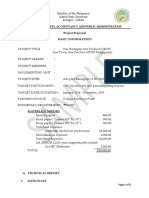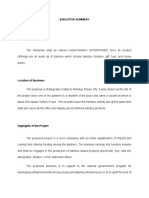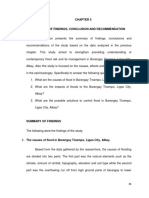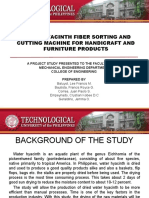The Problem and Its Background
The Problem and Its Background
Uploaded by
Crystian Kobee EmpeynadoCopyright:
Available Formats
The Problem and Its Background
The Problem and Its Background
Uploaded by
Crystian Kobee EmpeynadoOriginal Title
Copyright
Available Formats
Share this document
Did you find this document useful?
Is this content inappropriate?
Copyright:
Available Formats
The Problem and Its Background
The Problem and Its Background
Uploaded by
Crystian Kobee EmpeynadoCopyright:
Available Formats
Chapter 1
THE PROBLEM AND ITS BACKGROUND
This chapter includes the different essential elements: the introduction,
which contains the research rationale; the background of the study; the
conceptual framework; the scope and delimitation which identifies the major
variables, sub variables and the indicators; the significance of the study which
enumerates the beneficiaries of the study and the corresponding benefits each
will receive; and lastly, the notations.
Introduction
Fruit juices are worldwide consumables renowned for bringing a refreshing
experience to the consumer while altogether providing a high amount of nutrients
needed for the production of body energy and replenishment of anti-oxidants.
Throughout the years, fruit juice extraction techniques have evolved
drastically starting with the invention of grape pits dating back to 8000 BCE
where the makers of grape juice and wine fill the pits with freshly harvested
grapes and extract the juice by repeatedly stepping on the fruits with their bare
feet (Gat Foods, 2019). During the 16th Century, Italy started to regularly
produce lemonade as an import after the idea was conceived in the Middle East.
The mass production of lemonade was made possible by the hundreds and
thousands of people employed to extract the juice by squeezing lemons. And
soon after, in the 17th Century, orange juice followed the rise of lemon juice
(Muhammad Mushtaq, 2018).
Next to the popularization of fruit juices were the many researches done to
prove its numerous health benefits including its therapeutic power against cancer
and other diseases. However, despite the mass production of fruit juices, author
and raw food proponent, Dr. Norman Walker, still saw the need to make juicing
widely available. Thus, he invented the first juicing machine in the 1930s.
Then around mid-1950s, the Champion machine, the first masticating was
invented. The high speed (4,000 rpm) of the turning rod causes friction, which
heats the juice and destroys the live enzymes and other nutrients. And
eventually, in 1993, the world’s first twin-gear juice extractor, called the
Greenpower Juicer, was produced. The idea has been based on the old mortar-
and-pestle method of pressing out the maximum living nutrients from fruits and
vegetables without losing them to heat (Pat Crocker, 2017).
Here in the Philippines, aside from its health benefits and refreshing
factor, fruit juices are highly patronized because they serve as an alternative for
fruits and vegetables that are not available all year round.
This study focuses on creating a juice extractor that will help small to
medium scale farmers in maximizing their production of juices from their overage
of crops while minimizing the resources and effort exerted in the juicing process.
Background of the Study
Through the years, herbalists and traditional medicine practitioners were
the ones that most commonly ground up different ingredients to make healthy
beverages. In time however, things started changing.
Freshly juiced fruit has become a staple in many diets–particularly those
of busy, health-conscious consumers who can save time making (and perhaps
even chewing) their food without nutrients being missing. Fruit juice has also
been linked to claims that it can help both weight loss and detox your system
(Brown, 2019). But even before the varying ways of preparing it, juicing had
always been manual.
In a study by Beley (2011), during the period of manual juicing where
juicers would have to use hands and feet for extracting and separating liquid from
fiber, the production rate would only go up to as high as 400 gallons of juice per
week for a juicing company made of 40 laborers. This amount of juice serves
only up to 25-45 households.
The individual credited with the advent of the first juicer is health
practitioner Norman Walker. In 1936, Walker worked on and released a
book called Raw Vegetable Juices. This breakthrough in the juicing technology
has ushered in further studies on mass producing juice extractors which made
juice outputs leaps and bounds higher than that of manual production outputs
(Panasonic, 2017).
However, despite developments in the juicing industry, the small time
juicing businesses in 3rd world countries have always been left behind in terms
of availability of low-cost yet efficient juice extractors.
In the Philippines, juices have become a rising high-value commodity
among the community of health conscious consumers. This has become the
case since the continuous marketing of social media influencers and celebrities.
Health juices have slowly become a symbol of status and level of health
consciousness among young professionals aged 23-35 years old (Buzz, 2019).
However, the juicing industry has more to it than just providing health buffs a way
to derail themselves from horrible diets. More than it is a want, health juices are
definitely a need for those with real health conditions such as Type A and B
diabetes, Kidney issues, Blood issues, and more (Valdez, 2015). The
unavailability of health juices for the consumption of the general public has since
then been connected to the high prices of such products due to its high
production costs.
Within the Philippine agriculture, fruits and vegetables compromise a
strong and competitive sub-sector. This accounts for 31 percent (by value) of
agricultural output; and it has risen at a rate of 2.8 percent per year in the last
three decades compared to just 1.8 percent for agriculture as a whole (Briones,
2009).
In common with the remainder of agriculture, development of the fruits and
vegetables sub-sector is heavily dependent on technological change
(Weinberger and Lumpkin, 2007). For example, yield improvement for banana
and pineapple began in large plantations with access to international know-how,
which then spread to smaller farms; for mango, chemical spraying promoted its
area expansion and yield growth (David 2003).
Hence, there is a correlation between the production of fruit juices and
access to better fruit juice extractors.
Conceptual Framework
The illustration below shows the research paradigm for the development
of Fruit and Veggies Extractor for Small to Medium Scale Farm.
Design
Feasibility Construction
*Determine machine
*Determine Problem- specifications Design and Planning
More Efficient Way of Fabrication
Extracting Juice from *Determine auger Assembly
Overage Fruit and measurements Testing
Vegetable Crops of Modification
Small to Medium Scale *Gather Knowledge Evaluation
Farms Requirements: - Functionality
- Juice Extraction - Safety
*Identify
Objectives a Solution- - Auger Conveyor - Efficiency
More Efficient Juice Operation - Cost-effectiveness
Extracting
Generally,Machine
this study aims- toDesign
designand
andAssembly - Sanitation
fabricate a
through Fabricating of Motor, Belts, and ·
Existing
juice Machine
extractor with and Pulleys
the following characteristics:
Using New Auger
*Determine
1. Ability to extract juice both Software
from fruits and vegetables.
*Propose Project Plan Requirements:
- Auto of
2. Ability to preserve the seeds CAD
seed-bearing fruits and vegetables in order
*Get Approval on - SolidWorks
Project
to:Plan
*Gather Tools and · Output
*Assess
a) Expenses Equipment: and growing
Use them for germination ·
- Lathe Machine · More Efficient
seedlings. - Welding Machine Juice Extractor
- Electric Drills
b) Avoid having a bitter - Power
tasteTools
in the extracted
juices.
3. Multitask ability of peeling the fruit or vegetable, extracting juice, and
preserving the seeds.
4. Lower machine fabrication and production cost.
Significance of the Study
The result of the study will benefit the following:
1. Small to Medium Scale Farmers – through the multitask function of the
fabricated juice extractor machine with the new auger, the farmers will
be able to produce the juice product with less human error, less human
work, increased speed production, and limited contamination during
the process.
2. Consumers- The consumers will likely to receive a fine quality taste
product, due to the elimination of bitterness caused by crushed seeds,
with a much cheaper price because of the shorter process in the
extraction of juice.
3. Future Researchers- this study and research will benefit future
researchers who will be conducting their study and research near this
line of work.
Scope and Limitations
The scope of this research works within the range of:
· Standard material selection to ensure the quality of the machine.
· Selecting Appropriate fruit for the season in order to maximize the
Freshness of the product.
· Proper measurement, application of right Cutting techniques and Welding
techniques.
· Proper assembling of parts for construction of the machine.
· Providing Data of the efficiency of machine for future use.
The limitation of this study is as stated below:
· The juice extractor may be used for any kind of fruit and vegetable except
for banana and oil-bearing ones because the crops will undergo the
squeezing process and not pressing.
Definition of Terms
· Cake – the fruit/vegetable waste that is already squeezed. It is the residue
of juice extraction.
· Auger Screw - A screw conveyor or auger conveyor is a mechanism that
uses a rotating helical screw blade, usually within a tube, to move liquid or
granular materials.
· Extractor - a machine or device used to extract something.
· Pulp - a soft, wet, shapeless mass of material.
· Juice - the liquid obtained from or present in fruit or vegetables.
You might also like
- Table Set Up Table Skirting Floral ArrangementDocument1 pageTable Set Up Table Skirting Floral ArrangementEbberussd BansuanNo ratings yet
- Session 8. CECILIA DEL CASTILLO - Innovations and InitiativesDocument38 pagesSession 8. CECILIA DEL CASTILLO - Innovations and InitiativesADBGADNo ratings yet
- BSA AgExEd BALITAAN ROLANDO OUTLINEDocument28 pagesBSA AgExEd BALITAAN ROLANDO OUTLINEEvangeline TupazNo ratings yet
- Surigao Del Sur State University Cantilan Campus The Problem and Its SettingDocument12 pagesSurigao Del Sur State University Cantilan Campus The Problem and Its SettingJose CalipayanNo ratings yet
- Selection of Site 2Document3 pagesSelection of Site 2JaideHizoleSapulNo ratings yet
- Trash Segregation Rover System: Isabela State University Cauayan City, Isabela C C S, I C TDocument16 pagesTrash Segregation Rover System: Isabela State University Cauayan City, Isabela C C S, I C TAngelika LangitNo ratings yet
- Effects of Using A Modular Approach On Students Action ProposalDocument4 pagesEffects of Using A Modular Approach On Students Action ProposalNario Bedeser GemmaNo ratings yet
- Chapter 3-Operations PlanDocument16 pagesChapter 3-Operations PlanJC LaraNo ratings yet
- Waste Sorting System Using Arduino Technology For Benedicto CollegeDocument44 pagesWaste Sorting System Using Arduino Technology For Benedicto CollegeSharomaine SalvacionNo ratings yet
- Sample Project Proposal Template Design ThinkingDocument5 pagesSample Project Proposal Template Design ThinkingDavid WolfyNo ratings yet
- APPENDIX E Sample Thesis ComputationDocument5 pagesAPPENDIX E Sample Thesis ComputationPaula ParkNo ratings yet
- Practical Research 1, GROUP 5. CHASTITYDocument18 pagesPractical Research 1, GROUP 5. CHASTITYSarmiento, Raphael M.100% (1)
- Dear DiaryDocument6 pagesDear DiarySham Ly LaguspiNo ratings yet
- Design, Development and Fabrication of Precision Corn Seeder (Title Defense)Document14 pagesDesign, Development and Fabrication of Precision Corn Seeder (Title Defense)BlessyJoyPunsalanNo ratings yet
- Agela Thesis FinalDocument26 pagesAgela Thesis FinalCarmela EstradaNo ratings yet
- Academic Impact of COVID 19 Pandemic in The ABMDocument33 pagesAcademic Impact of COVID 19 Pandemic in The ABMMitos Cielo NavajaNo ratings yet
- Feasibility Study SampleDocument61 pagesFeasibility Study SampleMarvin BauraNo ratings yet
- Aquashade TechnologyDocument2 pagesAquashade TechnologyMariel Danica CaraNo ratings yet
- Chapter 2 (Reflection) JUNE 14, 2019Document3 pagesChapter 2 (Reflection) JUNE 14, 2019xyzNo ratings yet
- Research Capsule Proposal 1Document3 pagesResearch Capsule Proposal 1ZYNNELNo ratings yet
- Profile of TUPAD BeneficiariesDocument4 pagesProfile of TUPAD Beneficiariesjuvanniecolinares.819No ratings yet
- Expt Forces As Vectors Resultants and Equilibrants 1 1Document6 pagesExpt Forces As Vectors Resultants and Equilibrants 1 1Abegail MacatangayNo ratings yet
- Influence of Study Habits and Coping Mechanism To Course Enhancement PerformanceDocument41 pagesInfluence of Study Habits and Coping Mechanism To Course Enhancement PerformanceChoji HeiwajimaNo ratings yet
- Chapter-1: 1.1 Statement of The ProblemDocument34 pagesChapter-1: 1.1 Statement of The ProblemQari Noor Ullah SwatiNo ratings yet
- What Motivated You To Conduct or Choose The StudyDocument3 pagesWhat Motivated You To Conduct or Choose The StudyJenver GaviloNo ratings yet
- Chapter 5Document13 pagesChapter 5Alna JaeNo ratings yet
- Phlo 11 Ethics Module 2 AssessmentDocument1 pagePhlo 11 Ethics Module 2 AssessmentrickyNo ratings yet
- Weekly Progress Report CompilationDocument5 pagesWeekly Progress Report CompilationSheena Marie OuanoNo ratings yet
- Sample Capstone Chapter1Document18 pagesSample Capstone Chapter1neggywapp11738No ratings yet
- Thesis Final OutputDocument52 pagesThesis Final OutputHanah Abegail Navalta100% (1)
- New Chapter 5Document16 pagesNew Chapter 5May Anne Lopez SyNo ratings yet
- Practical Research 1 - Group 1Document19 pagesPractical Research 1 - Group 1Mack Jigo DiazNo ratings yet
- Maja Blanca Recipe 23Document3 pagesMaja Blanca Recipe 23FrancisRalfLlemitNo ratings yet
- Med CertDocument1 pageMed CertTOP ONE OBRERONo ratings yet
- Pns Bafps 62 2008 CucumberDocument10 pagesPns Bafps 62 2008 CucumberCarinna Saldaña - PierardNo ratings yet
- Research PPT Derivation of Roasted Breadnut Seed Artocarpus Camansi To Nutritious Flour For Bread and Noodle MakingDocument16 pagesResearch PPT Derivation of Roasted Breadnut Seed Artocarpus Camansi To Nutritious Flour For Bread and Noodle Makingcarlevannava62No ratings yet
- Mapanas Assessment ResultsDocument76 pagesMapanas Assessment Resultsmezo magayesNo ratings yet
- The Factors That Affect Students DecisioDocument55 pagesThe Factors That Affect Students DecisioBlueprint GraphicsNo ratings yet
- CHAPTER 3 QualitativeDocument5 pagesCHAPTER 3 QualitativeChristian Jay AdimosNo ratings yet
- NSTP Project Proposal FinalDocument7 pagesNSTP Project Proposal FinalPamela Joyce RiambonNo ratings yet
- Narrative Report Field Trips & Seminars Class 1 Semester 2020-2021Document1 pageNarrative Report Field Trips & Seminars Class 1 Semester 2020-2021virgilo dela rosaNo ratings yet
- Business Plan For Chickenjoyce Foodhauz: AGUILANDO, Anthony Seth TDocument23 pagesBusiness Plan For Chickenjoyce Foodhauz: AGUILANDO, Anthony Seth TAnthony Seth AguilandoNo ratings yet
- Basella Alba Extract As Potential Glass CleanerDocument14 pagesBasella Alba Extract As Potential Glass CleanerJandell LagarizaNo ratings yet
- How To Communicate Your Time Scale in A Research ProposalDocument1 pageHow To Communicate Your Time Scale in A Research ProposalShahin Samadli100% (2)
- Chapter 2 TemplateDocument17 pagesChapter 2 TemplateJay BetaizarNo ratings yet
- Statement of The ProblemDocument1 pageStatement of The ProblemWilmar Laforga CimatuNo ratings yet
- Porters 5Document3 pagesPorters 5Maureen Joy Esguerra ZamudioNo ratings yet
- Trash Items Found: Garbage Bin 1 Garbage Bin 2 Garbage Bin 3Document4 pagesTrash Items Found: Garbage Bin 1 Garbage Bin 2 Garbage Bin 3Olsen Soqueña100% (1)
- Adopting or Adapting An InstrumentDocument3 pagesAdopting or Adapting An InstrumentAyesha Calmerin Penuela100% (1)
- Bagante ThesisDocument21 pagesBagante ThesisKimberly MartinezNo ratings yet
- Physics 1 Research Paper XEROX MACHINEDocument4 pagesPhysics 1 Research Paper XEROX MACHINECorazon GerodiasNo ratings yet
- Impacts of Organizational Culture On The Financial Performance of Small Businesses in General Santos City Patun OgDocument99 pagesImpacts of Organizational Culture On The Financial Performance of Small Businesses in General Santos City Patun OgMarvin Agustin De CastroNo ratings yet
- Eteeap Application Form Pangasinan State UDocument1 pageEteeap Application Form Pangasinan State UMarcial Jr. MilitanteNo ratings yet
- Inventory of Grass SpeciesDocument27 pagesInventory of Grass SpeciesThunder NayeonNo ratings yet
- Home-Based Broiler Production Management and Practices at Vargas Santa Ignacia TarlacDocument14 pagesHome-Based Broiler Production Management and Practices at Vargas Santa Ignacia TarlacJC GAMING100% (1)
- Market ResearchDocument17 pagesMarket ResearchAngela YuzhongNo ratings yet
- Narrative Report.Document3 pagesNarrative Report.Alexandra FuentesNo ratings yet
- The Problem and Its BackgroundDocument23 pagesThe Problem and Its BackgroundCrystian Kobee EmpeynadoNo ratings yet
- Astesj 050560Document9 pagesAstesj 050560KrishNo ratings yet
- Olaniyanand ObajemihiDocument8 pagesOlaniyanand ObajemihiAbelNo ratings yet
- Water Hyacinth Fiber Sorting and Cutting Machine For Handicraft and Furniture ProductsDocument15 pagesWater Hyacinth Fiber Sorting and Cutting Machine For Handicraft and Furniture ProductsCrystian Kobee EmpeynadoNo ratings yet
- The Problem and Its BackgroundDocument23 pagesThe Problem and Its BackgroundCrystian Kobee EmpeynadoNo ratings yet
- Mesl Problems Set 2Document5 pagesMesl Problems Set 2Crystian Kobee EmpeynadoNo ratings yet
- Development of A Digester With Shredder For Biogas Production Using Animal and Kitchen WastesDocument14 pagesDevelopment of A Digester With Shredder For Biogas Production Using Animal and Kitchen WastesCrystian Kobee EmpeynadoNo ratings yet
- Kinematic and StressesDocument41 pagesKinematic and StressesCrystian Kobee EmpeynadoNo ratings yet
- Chapter 4 UPDATED 4.1 4.3 4.4Document18 pagesChapter 4 UPDATED 4.1 4.3 4.4Crystian Kobee EmpeynadoNo ratings yet
- Technological University of The Philippines: Vice President For Academic AffairsDocument1 pageTechnological University of The Philippines: Vice President For Academic AffairsCrystian Kobee EmpeynadoNo ratings yet
- Specifications For Sprinkler System Installation in Esep BuildingDocument25 pagesSpecifications For Sprinkler System Installation in Esep BuildingCrystian Kobee EmpeynadoNo ratings yet
- Fossil Fuels Oil and GasDocument12 pagesFossil Fuels Oil and GasCrystian Kobee EmpeynadoNo ratings yet
- The Problem and Its BackgroundDocument34 pagesThe Problem and Its BackgroundCrystian Kobee EmpeynadoNo ratings yet
- Wrapper Maker and Wrapping Machine For EmpanadaDocument73 pagesWrapper Maker and Wrapping Machine For EmpanadaCrystian Kobee Empeynado100% (1)
- Cooling and DehumidificationDocument4 pagesCooling and DehumidificationCrystian Kobee EmpeynadoNo ratings yet
- Hvac Lab 3Document24 pagesHvac Lab 3Crystian Kobee EmpeynadoNo ratings yet
- Fire Protection System PDFDocument15 pagesFire Protection System PDFCrystian Kobee EmpeynadoNo ratings yet
- NAME: Gagote, Zandro A. Scholarship Program: R.A. 7687 COURSE: B.S. Mechanical Engineering SCHOOL: TUP-Manila Year of Award: 2015Document1 pageNAME: Gagote, Zandro A. Scholarship Program: R.A. 7687 COURSE: B.S. Mechanical Engineering SCHOOL: TUP-Manila Year of Award: 2015Crystian Kobee EmpeynadoNo ratings yet
- NAME: Adalid, John Lowell R. Scholarship Program: R.A. 10612 COURSE: B.S. Mechanical Engineering SCHOOL: TUP-Manila Year of Award: 2017Document1 pageNAME: Adalid, John Lowell R. Scholarship Program: R.A. 10612 COURSE: B.S. Mechanical Engineering SCHOOL: TUP-Manila Year of Award: 2017Crystian Kobee EmpeynadoNo ratings yet
- Electroplating Anodizing Metal PDFDocument53 pagesElectroplating Anodizing Metal PDFCrystian Kobee EmpeynadoNo ratings yet
- Dear Student-Trainee:: Guidelines For Student-TraineesDocument2 pagesDear Student-Trainee:: Guidelines For Student-TraineesCrystian Kobee EmpeynadoNo ratings yet
- Electroplating Anodizing Metal PDFDocument53 pagesElectroplating Anodizing Metal PDFCrystian Kobee EmpeynadoNo ratings yet
- Industrial Waste Water PDFDocument28 pagesIndustrial Waste Water PDFCrystian Kobee EmpeynadoNo ratings yet
- Shear and Compressive Strength Parallel To Grain of Mango Mangifera Indica at Two Moisture Regimes in A Humid EnvironmentDocument6 pagesShear and Compressive Strength Parallel To Grain of Mango Mangifera Indica at Two Moisture Regimes in A Humid EnvironmentCrystian Kobee EmpeynadoNo ratings yet
- Img 20181121 0001Document1 pageImg 20181121 0001Crystian Kobee EmpeynadoNo ratings yet
- Philippine Policy of Raw Energy Resources Utilization and ExploitationDocument3 pagesPhilippine Policy of Raw Energy Resources Utilization and ExploitationCrystian Kobee EmpeynadoNo ratings yet
- EXERCISE (PERSONAL PROTECTIVE EQUIPMENT) : Choose The Letter of The Correct AnswerDocument3 pagesEXERCISE (PERSONAL PROTECTIVE EQUIPMENT) : Choose The Letter of The Correct AnswerCrystian Kobee EmpeynadoNo ratings yet
- Water Hyacinth 2Document21 pagesWater Hyacinth 2Crystian Kobee EmpeynadoNo ratings yet
- Ess3A: Mechanics of Deformable BodiesDocument1 pageEss3A: Mechanics of Deformable BodiesCrystian Kobee EmpeynadoNo ratings yet
- Bhutan Logistics-Trade DirectoryDocument54 pagesBhutan Logistics-Trade DirectoryGopu DasNo ratings yet
- Chapter 9 Risk ManagementDocument63 pagesChapter 9 Risk ManagementNiño Michael PagcaliwaganNo ratings yet
- Lesson 3 Alcohol and Its EffectsDocument23 pagesLesson 3 Alcohol and Its EffectsSuriya KakaniNo ratings yet
- Grzegorz Jawor, AUCI, 2, 2019Document17 pagesGrzegorz Jawor, AUCI, 2, 2019Ilie LiviuNo ratings yet
- Flavor ModulationDocument4 pagesFlavor Modulationcel012b1No ratings yet
- The Complete Ramen For Beginners - A Step-By-Step Guide To - Shuusei Sakata - 2021 - Anna's ArchiveDocument292 pagesThe Complete Ramen For Beginners - A Step-By-Step Guide To - Shuusei Sakata - 2021 - Anna's ArchiveBeckenbauer ErnstbergerNo ratings yet
- A1 SITHCCC019 Worksheets Ver October 2018Document19 pagesA1 SITHCCC019 Worksheets Ver October 2018Pitaram Panthi50% (2)
- Textos Past Simple and Continuous 2Document5 pagesTextos Past Simple and Continuous 2Alicia Guerra FernándezNo ratings yet
- International HealthDocument46 pagesInternational HealthammaraNo ratings yet
- Mitd CoursesDocument21 pagesMitd CoursesAvinash HeeraNo ratings yet
- Going To The RestaurantDocument4 pagesGoing To The RestaurantUBALDONo ratings yet
- Dyspepsia and Homeopathic TreatmentDocument62 pagesDyspepsia and Homeopathic Treatmentdrmsupriya100% (1)
- Lesson Plan in Kench SaltingDocument8 pagesLesson Plan in Kench SaltingFLORDELONA CAYANo ratings yet
- Pierce NzeribeDocument1 pagePierce Nzeribeapi-548140511No ratings yet
- A Meeting Planner's Guide To Catered EventsDocument26 pagesA Meeting Planner's Guide To Catered EventsjaykumariyerNo ratings yet
- Callan Method 3Document170 pagesCallan Method 3Erika Ribeiro100% (3)
- Roal Dahl - TASTE - GLOSSARY AND ACTIVITIESDocument3 pagesRoal Dahl - TASTE - GLOSSARY AND ACTIVITIESAbril_32No ratings yet
- Mud Crab FeedsDocument34 pagesMud Crab FeedsCharles StephenNo ratings yet
- English 4 q1 St4Document2 pagesEnglish 4 q1 St4Catherine AbabonNo ratings yet
- Science6 - Q1-WK-1 FOR STUDENTDocument14 pagesScience6 - Q1-WK-1 FOR STUDENTMaricar Escarsa Villanueva-MinoyNo ratings yet
- Presentation On OF ": Marketing MixDocument21 pagesPresentation On OF ": Marketing MixAparnaNo ratings yet
- WhatsApp Chat With TAHIRDocument2 pagesWhatsApp Chat With TAHIRsalmaanNo ratings yet
- Attitude Makes The DifferenceDocument5 pagesAttitude Makes The DifferenceMyWonderStudioNo ratings yet
- Wa0001.Document10 pagesWa0001.SintyaNo ratings yet
- Sach A2Document30 pagesSach A2Ngọc Trinh Nguyễn TrungNo ratings yet
- Open Sandwich: 2. 2. History SejarahDocument6 pagesOpen Sandwich: 2. 2. History SejarahBocah NdesoNo ratings yet
- MUET S2 2024 BOOKLET 5 AnswerDocument6 pagesMUET S2 2024 BOOKLET 5 AnswerNursa'adahNo ratings yet
- Ds Nha Nhap Khau Ns Han Quoc Tiem NagDocument18 pagesDs Nha Nhap Khau Ns Han Quoc Tiem Nagsales01100% (1)
- Hansel & GretelDocument22 pagesHansel & GretelqueiteimoonNo ratings yet
- SmoothiesDocument1 pageSmoothiesCyrus IsanaNo ratings yet

















































































































